An Autumn Bounty of Math-Building Activities
As the leaves begin to change colors and jackets and hats become a part of our days, our math play takes on a whole new dimension. Earlier in the year, we talked about all of the collecting that we do throughout our days here. These collections take on a new significance as we use our found treasures to foster the development of early math skills. Recently, a collection of nature’s autumn bounty gave us a magical morning of play and exploration that enabled us to meet our curriculum standards without a single mention of the word math!
It started simply enough with the bowl of beautiful autumn colors and loose parts pictured below:



The children began sorting the items in the bowl almost immediately—without any prompting. There was no discussion about what we were doing. This was very intentional and calculated. When children sort materials, they begin to understand that certain things have similarities and differences.



Let’s think of these groupings as sets. Sets are a collection of items that have been classified together because they have something in common. Defining these sets of matches is a prerequisite for counting and comparing. Before we can figure out how many pine cones there are, we need to separate the pine cones from the buckeyes.


Classifying is the skill of grouping or sorting items by similar characteristics. Being able to match items and explain why they go together is an important part of cognitive development. Children between the ages of three and four enjoy sorting and classifying objects by one characteristic. By allowing more time for exploration and play, you will will give the children opportunities to increase their classification by more than one characteristic.
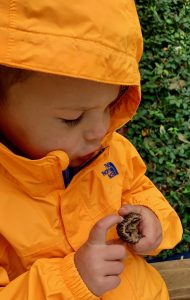
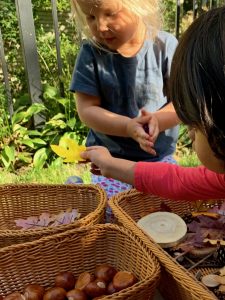
Matching is a simple form of sorting. Matching helps children identify attributes that are the same and take notice of details that are a bit different. Children can match by size, shape, color or one to one.
Seriation is arranging objects in order by size, location or position. There was great discussion and collaboration as we discussed the sizes of pine cones and what order they should be arranged in.



Patterns are sequences that repeat. The ability to recognize patterns supports math skills. Pattern recognition helps children make predictions about what will come next. Patterns are an important part of spatial thinking. Once children begin to spot patterns, they will see them everywhere in their surroundings and their daily routines. Pattern awareness is a form of early algebraic thinking.
The children were engaged and spent a great deal of time arranging their materials in many sorted piles and patterns. By engaging in these simple mathematical experiences, the children became more proficient at problem-solving, reasoning, making predictions and making connections in their world. To help the children in your care develop these foundational math skills, keep it simple! Take your students outdoors! The curriculum is waiting for you in those autumn treasures just waiting to be found!
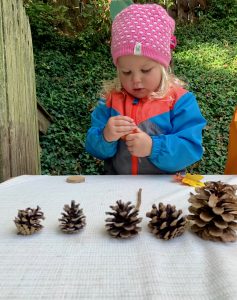
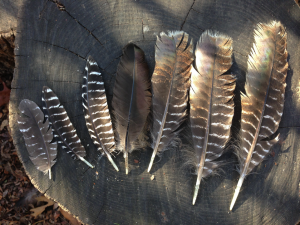
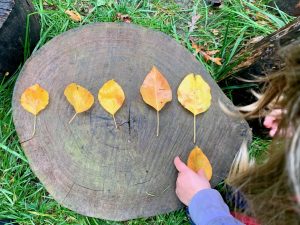
This was a well thought out lesson that can span during the autumn. Sorting, color recognition, same and different attributes of the collections lends itself to various lessons that can build on each skill. The children are very engaged, discussions and questions will be a part of the lessons. Problem-solving will develop when the children begin to understand the desired skills that are a goal of the lessons. The concept of patterning will create more problem solving skills when the begin to think of different ways to create patterns with the material that is provided. Creating a greater awareness of their surroundings. Good Lessons
I really like how you kept collecting and then used the collection with sorting and patterns.
This is a great way of encouraging children to engage in learning about patterns. Children need ample opportunities to explore their world around them and what better way to do it than with hands-on exploration of nature.
I’ve have taking my student on nature walks and collected all kinds of different leaves. When we get to the classroom, the children are ask to sort the leaves by shape. We have found long leaves, heart shape and many other. We have sort the leaves by colors too, how many and which group has more just to name a few.
I love the idea of collecting data by getting outdoors and the children can choose their own materials.
I Like how you used the leafs to create a pattern.
I like the hands-on activities
Understanding this activity, helps children look for similarities (comparing), count how may are the same and analyzing data. It looks like a simple activity to kids but it explores math in many ways. It also keeps them engaged!
You could use this data to make a pictograph.
I love this activity. It provide so many possibilities for young children. The collection could be use to collect data by sorting and grouping the different items. It was a great way to experience nature and explore math.
this is a great idea, i never thought of using outdoor plant life that way, I will use this activity whenever we are allowed to return to work.
great ideas , love the hands on and outdoor activities to get children to learn
I simply like the idea of nature walk during fall where kids could observe patterns in nature and it is really a great hands on activity for kids outside classroom
I like this idea not only to use fir patterning but you can also use it to decide on how many more of one thing you need to make it even to the other or which one has more or which one has less. you can also have the children use team work. to spread out and look for different objects; rocks, leaves, acorns, pinecones, sticks. and then come back together to compare and contrast which has more, less, or the same amount.
Great activity that would be engaging while incorporating math and science. This is the type of activity that opens up conversation about so many different things and can include learning on many levels through children’s innate curiosity.
So many “free” manipulatives out in our yards this season. Thank you for the fabulous ideas!
Absolutely love this! I love fall and nature and am going to do this this week thank you!
Michelle Lukasik
What a lovely lesson! Not only does it engage the children’s senses, it teaches them about the natural world *and* math. I’ll certainly use this in my daycare as we collect autumnal items on our walks.